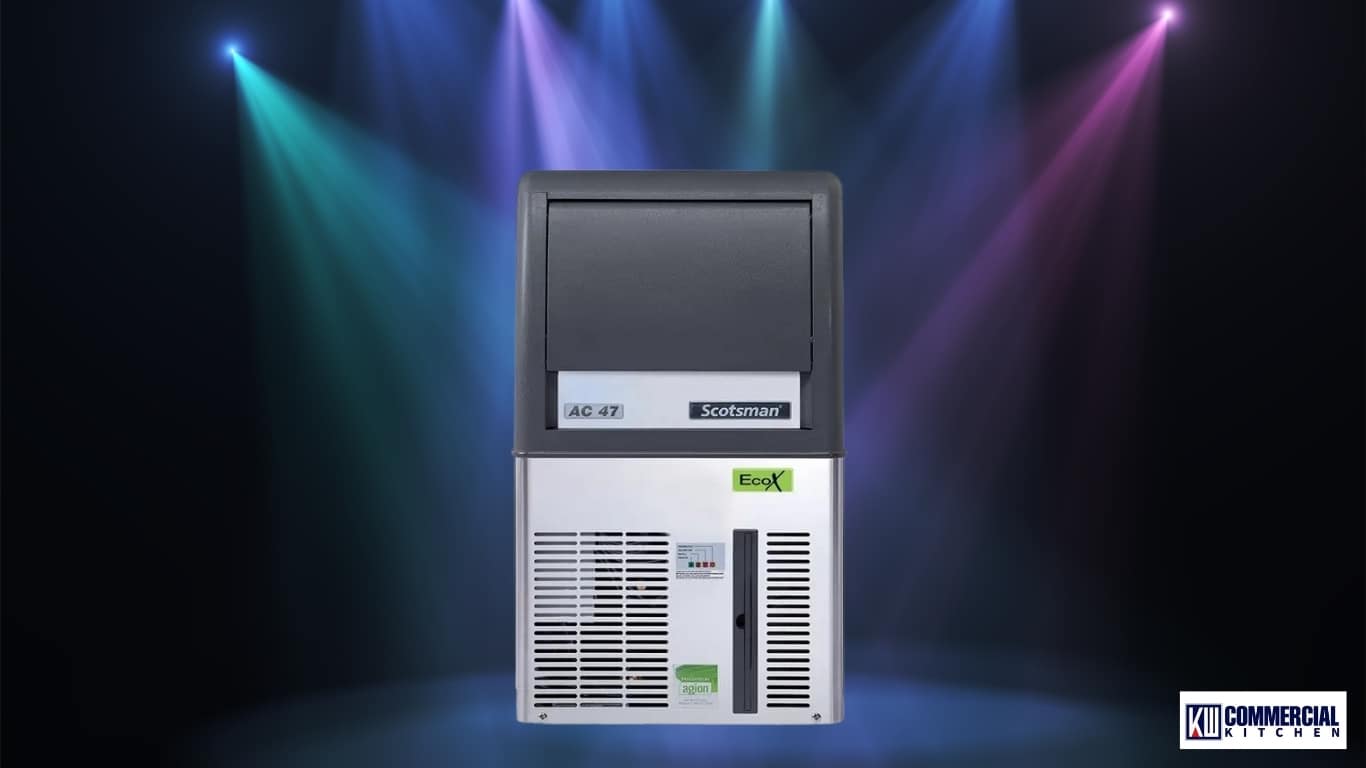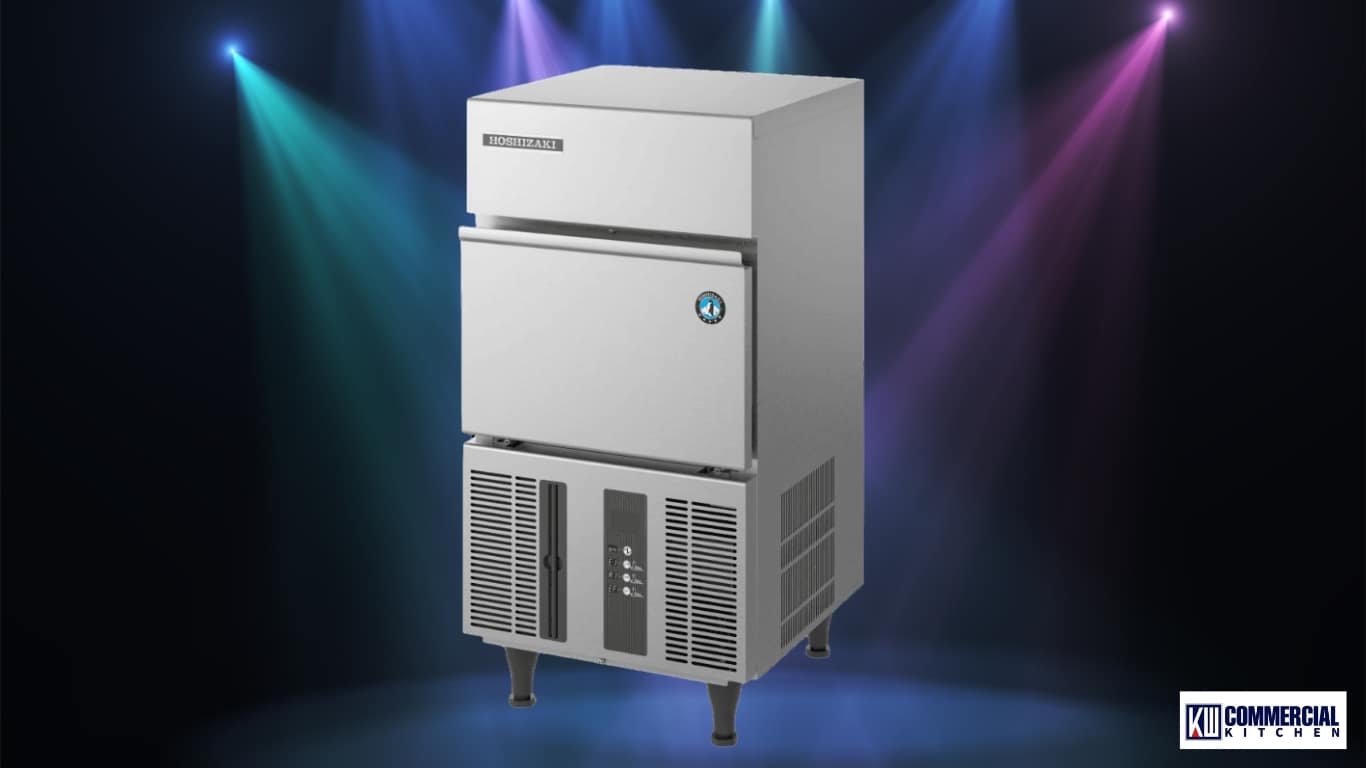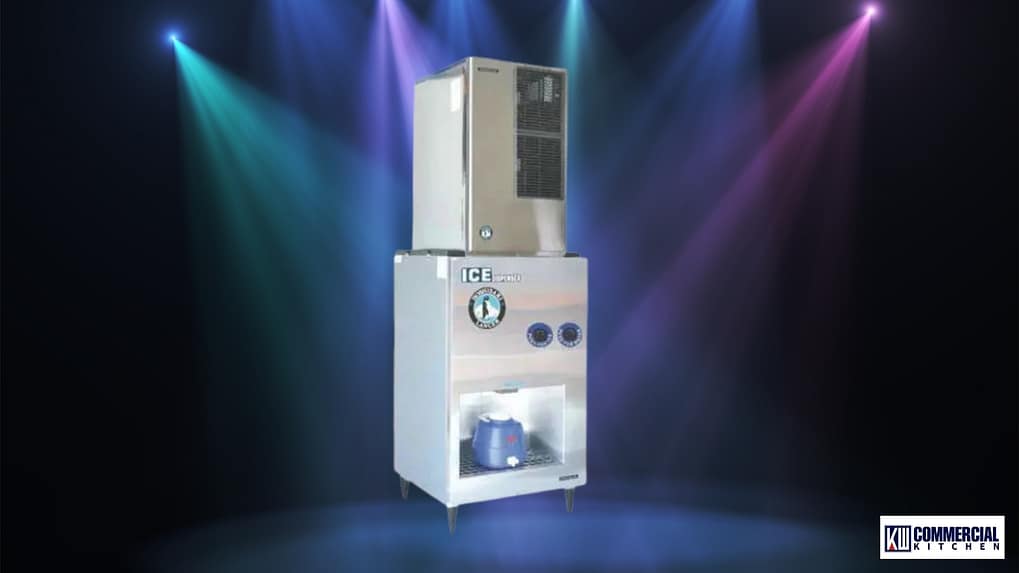Commercial Ice Makers · Australia · 2025
Australia’s 2025 Ice Machine Guide — Cubes, Nugget & Flake; Sizing, Water & Filtration, Cleaning, Troubleshooting & ROI
No guesswork. This is a hands‑on, Australia‑specific guide to picking and running a commercial ice machine: ice types (dice, gourmet, nugget, flake), self‑contained vs modular, air‑ or water‑cooled, how to size by peak hour, the water & filtration choices that stop scale and off‑tastes, cleaning SOPs, troubleshooting and five‑year ROI. Built for bars, cafés, seafood, healthcare and events.
1) Executive summary
Successful ice programs start with five good decisions: ice type (what your menu needs), capacity vs storage (size to peak hour and buffer with a bin), format (self‑contained undercounter vs modular head + bin vs dispenser), cooling method (air, water or remote) and water treatment (filtration/scale control matched to local chemistry). Everything else — service calls, taste complaints, staff time — flows from those choices.
2) Ice types & where they win
| Ice type | Typical size/shape | Melt rate | Best for | Pros | Watch‑outs |
|---|---|---|---|---|---|
| Dice / Half‑dice | Rectangular cubes; half‑dice for fast fill | Moderate | Soft drinks, basic cocktails, general service | Efficient harvest, versatile, reliable dispense | Not as slow‑melt as gourmet |
| Gourmet / Large clear cubes | Large round/solid cubes | Slow | Premium cocktails & spirits | High clarity, presentation | Lower kg/24 h per footprint; needs good water |
| Nugget / Pearl / Chewable | Compressed flakes, chewable | Fast–moderate | QSR drinks, healthcare hydration | Great mouthfeel; blends well | Some waste if untrained staff overfill |
| Flake | Snow‑like flakes | Fast | Seafood displays, butchery, food processing | Excellent surface contact and cooling | Not for long drinks; high surface melt |
| Crescent / Bullet | Crescent/bullet shapes | Moderate | General venues, ice wells, dispensers | Free‑flowing, less bridging | Presentation not for high‑end cocktails |
See options across brands such as Hoshizaki, Scotsman, Bromic, Blizzard and Polar in our commercial ice maker category.
3) Machine formats & cooling methods
| Format | What it is | Pros | Watch‑outs | Good for | Link |
|---|---|---|---|---|---|
| Self‑contained undercounter | One cabinet with maker + small bin | Simple install; compact footprint | Limited storage; hot rooms reduce output | Cafés, small bars, offices | Browse self‑contained |
| Modular head + bin | Maker head on top of separate insulated bin | Scalable capacity and storage; serviceable | Needs vertical clearance; correct bin sizing | Bars, clubs, seafood, banquets | All ice makers |
| Dispenser / Crusher | Hands‑free dispense; optional crush | Hygienic FOH; portion control | Capacity lower than modular + bin | Hotels, healthcare, stadiums | Dispensers & crushers |
Cooling methods
| Cooling | Pros | Watch‑outs | Best use |
|---|---|---|---|
| Air‑cooled | Low water cost; simple plumbing | Needs free airflow; dump heat to room | Most bars/cafés with ventilation space |
| Water‑cooled | Stable in hot rooms; quiet in FOH | Uses more water; check local charges/policy | Sites with heat/noise constraints |
| Remote condenser | Lowest heat/noise at the bar | Higher install complexity; roof space | Premium bars, large venues |

4) How to size capacity (kg/24 h) by venue
Size for the peak hour and let the bin buffer quieter periods. Use the quick recipes below, then select a machine whose kg/24 h at hot conditions covers your requirement.
| Venue | Rule of thumb | Worked example | Peak hour kg | Recommended production |
|---|---|---|---|---|
| Bar (cocktails & mixed) | Seats × drinks/seat@peak × ice per drink (g) ÷ 1000 | 80 × 2.0 × 180 g ÷ 1000 | 28.8 kg/h | ≥ 30 kg/h capability with 90–120 kg bin |
| Café (smoothies) | Blends/h × 250 g ÷ 1000 | 60 × 0.25 | 15 kg/h | ≥ 15–18 kg/h; 40–60 kg bin |
| Seafood display | Display area (m²) × 40–60 kg/m² per day | 4 m² × 50 | — | ≥ 200–250 kg/day flake; floor drain access |
| Healthcare hydration (nugget) | Residents × 0.8–1.2 kg/day | 120 × 1.0 | — | ≥ 120 kg/day nugget + hygienic dispenser |
5) Water quality, BWT filtration & scale control
Water chemistry drives taste, clarity and reliability. Sediment causes clogged valves and jets; hardness scales the evaporator; organics cause odour. A matched filtration plan prevents most call‑outs.
Filter stack basics
- Sediment + carbon for particulates and chlorine/odours.
- Scale inhibitor (polyphosphate or equivalent) to reduce hardness deposits; in very hard or high‑TDS sites consider softening or RO per brand guidance.
- Pressure & flow: many heads include gauges — aim for the band the manual specifies.
BWT mapping (simple guide)
| Daily ice (kg) | Water challenge | Filter approach | Change interval |
|---|---|---|---|
| ≤ 60 kg | Moderate hardness, chlorine taste | Single BWT sediment+carbon with scale inhibitor | 6 months or by litres counter |
| 60–150 kg | Hard water or turbidity | Dual: sediment pre‑filter + BWT carbon/inhibitor | 3–6 months depending on load |
| ≥ 150 kg | Very hard / high TDS | Softening or RO system + polishing carbon (brand‑approved) | Per system spec |
6) Installation & compliance (AU)
- Location & ventilation: keep air intakes/exhausts clear; don’t box‑in under benches; respect side/rear/overhead clearances in the manual.
- Electrical: dedicated circuit and isolation to AS/NZS 3000 (Wiring Rules). Confirm phase/amps and RCD as required.
- Plumbing & drainage: potable water connection and drain to AS/NZS 3500 principles. Provide fall to waste or a pumped drain if below the trap; avoid long flat runs and kinks.
- Food safety: in Australia, ice is handled as food under the Australia New Zealand Food Standards Code — use clean scoops, covered bins, dedicated storage and hand‑washing protocols.
- Refrigerants: many newer models use hydrocarbon R290; installation/servicing must be performed by licensed technicians following the manufacturer’s safety instructions.
7) Energy, water & refrigerants — what to compare
| Spec line | Why it matters | Typical ranges | Notes |
|---|---|---|---|
| kWh/24 h | Running cost | ~3–12 kWh/24 h (undercounter to larger modular) | Higher ambient raises consumption |
| L/kg of ice | Water cost | ~1.0–1.5 L/kg becomes ice; water‑cooled adds cooling water | Water‑cooled can add several L/kg for heat rejection |
| Ambient/water rating | Production at heat | Ratings commonly listed at 21/10 °C and 32/21 °C | Use the hotter figure for realistic planning |
| Refrigerant | Efficiency & service | R290 (hydrocarbon) common; legacy HFC on older units | Service only by licensed techs |
8) Cleaning & sanitation (HowTo)
Daily (front‑of‑house habits)
- Wash and air‑dry the ice scoop; store it outside the bin in a clean holder.
- Wipe splash zones and bin lid; keep bin closed when not scooping.
- After long idle periods, discard the first harvest (stale water/ice).
Weekly/fortnightly
- Clean air filters and condenser fins; vacuum dust from intake grills.
- Sanitise bin liner and baffles with food‑safe sanitizer; rinse and air‑dry.
- Check water filter pressure and note the reading in your log.
Quarterly deep clean (typical — check your brand)
- Isolate power/water. Empty bin and remove internal parts per manual.
- Run a descale/clean cycle with manufacturer‑approved chemicals and dilution.
- Brush the evaporator plate gently; rinse until pH‑neutral and odour‑free.
- Reassemble, sanitize food‑contact surfaces, flush lines, then make and discard the first batch.
9) Troubleshooting matrix
| Symptom | Likely cause | First aid | When to call service |
|---|---|---|---|
| No ice / low harvest | Hot room; dirty condenser; clogged filter; low water pressure; bin full sensor stuck | Ventilate; clean filters/fins; change water filter; check bin level | Refrigeration fault; inlet valve/float; control board |
| Soft/slushy cubes | High water temp; poor freeze; scale on evaporator | Cool inlet water if possible; clean/descale | Thermostat/probe or gas charge issues |
| Bridging in bin | High humidity; wrong bin for cube type | Break up; fit anti‑bridging kit | Change bin style or add agitation |
| Leaks / drain backflow | No fall to waste; blocked drain; pump fault | Clear blockage; raise outlet to correct fall | Replace drain pump/lines |
| Bad taste/odour | Exhausted filters; stagnant lines; dirty bin | Replace filters; sanitize bin and lines | Investigate water source contamination |
| Machine trips power | Moisture ingress; failing component | Isolate and dry if safe | Licensed electrician/technician inspection |

10) Brand snapshot & shortlists
Hoshizaki
Premium cube clarity, quiet harvest cycles, strong reliability and support. Excellent for cocktail bars and hotels.
Scotsman
Broad modular and dispenser range, including nugget/flake specialists. Great for venues and healthcare hydration.
Bromic
Value‑driven portfolio matched to AU conditions across undercounter and modular formats.
Blizzard
Cost‑effective undercounter machines for cafés, small bars and back‑up capacity.
Polar
Light‑duty applications and entry budgets where duty cycle is modest.
BWT (Filtration)
Cartridge systems to protect evaporators and improve taste; size by site hardness and kg/day.
11) Venue playbooks
Premium cocktail bar
- Modular dice/gourmet cube head + insulated bin; consider remote condenser to remove heat/noise.
- Optional nugget machine for highballs; separate scoop and bar ice wells.
- Strong BWT filtration for clarity; bin anti‑bridging kit.
Café / smoothie bar
- Self‑contained undercounter (air‑cooled) sized to blend cycles; quick access beside blender station.
- Change filters on schedule; discard first harvest after overnight idle.
Seafood & butchery
- Flake maker + floor drain; sloped benches for run‑off; sanitation plan for display pans.
- Match production to display refresh schedule on hot days.
Healthcare / offices
- Nugget/pearl dispenser for hygiene; portion control; dedicated hand‑wash nearby.
12) ROI — bagged ice vs owning a machine
| Item | Assumption | Math | Result |
|---|---|---|---|
| Bagged ice cost | $5 per 5 kg ($1/kg); 40 kg/day × 300 days/year | $1 × 40 × 300 | $12,000 / year |
| Ice machine energy | 6 kWh/day × $0.30/kWh × 300 days | 6 × 0.30 × 300 | $540 / year |
| Water & filters | ~1.2 L/kg × 40 kg/day; water $4/kL; filters $400/yr | 0.048 kL/day × $4 × 300 + 400 | $458 / year |
| Service allowance | $250 / year | — | $250 / year |
| Capex amortised | $4,500 over 5 years | $900 / year | $900 / year |
| Total owning cost | energy + water + filters + service + capex | $540 + $458 + $250 + $900 | $2,148 / year |
| Savings vs bagged | $12,000 − $2,148 | — | ~$9,852 / year (payback ≈ 5–6 months) |
13) Mini case studies
CBD cocktail bar (Sydney)
Switched to modular gourmet cube + remote condenser. Heat/noise at the bar fell dramatically, cube clarity improved with BWT filtration and monthly bin sanitise. Bagged‑ice spend eliminated; payback recorded at under 10 months.
Independent café (Melbourne)
Self‑contained undercounter air‑cooled unit sized to peak blends; first‑harvest discard SOP ended off‑tastes. Filter cartridges logged and changed on schedule — zero taste complaints through summer.
Seafood retailer (Brisbane)
New flake maker with floor drain and improved run‑off; display integrity held through a 35 °C heatwave. Staff time saved 25 min/day vs bagged‑ice top‑ups.
14) FAQ
How much ice do I need per guest or drink?
For mixed drinks plan ~180–220 g per serve; smoothies ~250 g per blend; seafood displays 40–60 kg/m² per day. Size to your busiest hour and use a bin as a buffer.
Air‑cooled vs water‑cooled — which is better in Australia?
Air‑cooled is simplest and cheapest on water; ensure ventilation. Water‑cooled is quieter and stable in hot rooms but consumes more water; check local rules and charges.
How often should I clean an ice machine?
Daily FOH habits + weekly/fortnightly filter/bin sanitation + quarterly deep clean with brand‑approved chemicals. Keep a log and change water filters on schedule.
What if my ice tastes bad?
Replace water filters, sanitize bin and lines, purge the first harvest after idle, and review local water changes (e.g., seasonal chlorination).
Can I install an ice machine under a bench?
Yes for many self‑contained undercounters. Keep ventilation clear and ensure drain fall or a pumped drain.
Which brands do you recommend?
We stock and shortlist across Hoshizaki, Scotsman, Bromic, Blizzard, Polar and BWT filtration — we’ll match capacity, format and budget to your site.
15) References & notes
- Australia New Zealand Food Standards Code: ice hygiene and equipment cleanliness obligations for food businesses.
- AS/NZS 3500: plumbing and drainage — potable water connections and waste fall principles.
- AS/NZS 3000: Electrical installations (Wiring Rules).
- Always follow the specific manufacturer installation, operation and cleaning manual for your model.

